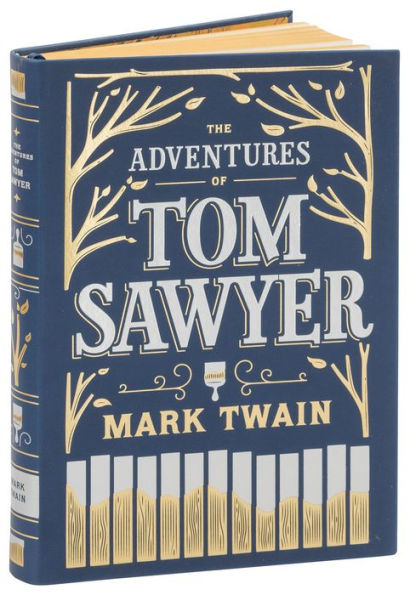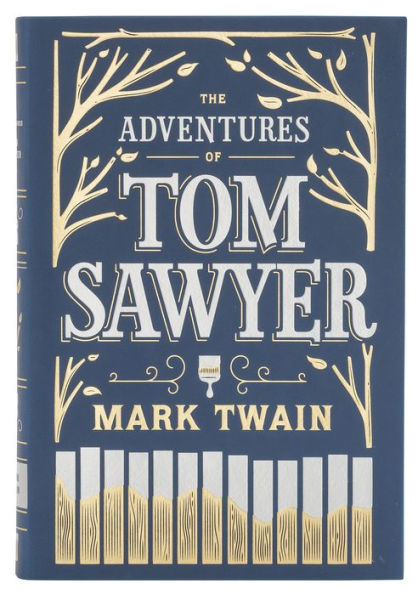Lovable heroes and heroines abound in children’s literature, but let’s be honest: many of them have blind spots, and they rarely act alone. More often than not, there’s a dry wit beneath their wings, and it typically belongs to an endearing sidekick who makes up for reduced beauty and grace with humor and hard work. […]
That rascal Tom Sawyer is having quite a time! In just a few months' time he's gotten engaged to the new girl in town, witnessed a murder, stayed in a haunted house, found buried treasure, been lost in a cave, and watched his own funeral. But that's Tom for you—an unpredictable mix of youthful innocence and mischief.
First published in 1876, Mark Twain's The Adventures of Tom Sawyer has delighted generations of readers who believe that they themselves have a little bit of Tom's spunk and irascibility in them. This volume is one of Barnes & Noble's Collectible Editions classics. Each volume features authoritative texts by the world's greatest authors in an exquisitely designed foil-stamped binding, with distinctive colored edging and an attractive ribbon bookmark. Decorative, durable, and collectible, these books offer hours of pleasure to readers young and old and are an indispensable cornerstone for any home library.
1116670755
First published in 1876, Mark Twain's The Adventures of Tom Sawyer has delighted generations of readers who believe that they themselves have a little bit of Tom's spunk and irascibility in them. This volume is one of Barnes & Noble's Collectible Editions classics. Each volume features authoritative texts by the world's greatest authors in an exquisitely designed foil-stamped binding, with distinctive colored edging and an attractive ribbon bookmark. Decorative, durable, and collectible, these books offer hours of pleasure to readers young and old and are an indispensable cornerstone for any home library.
The Adventures of Tom Sawyer (Barnes & Noble Collectible Editions)
That rascal Tom Sawyer is having quite a time! In just a few months' time he's gotten engaged to the new girl in town, witnessed a murder, stayed in a haunted house, found buried treasure, been lost in a cave, and watched his own funeral. But that's Tom for you—an unpredictable mix of youthful innocence and mischief.
First published in 1876, Mark Twain's The Adventures of Tom Sawyer has delighted generations of readers who believe that they themselves have a little bit of Tom's spunk and irascibility in them. This volume is one of Barnes & Noble's Collectible Editions classics. Each volume features authoritative texts by the world's greatest authors in an exquisitely designed foil-stamped binding, with distinctive colored edging and an attractive ribbon bookmark. Decorative, durable, and collectible, these books offer hours of pleasure to readers young and old and are an indispensable cornerstone for any home library.
First published in 1876, Mark Twain's The Adventures of Tom Sawyer has delighted generations of readers who believe that they themselves have a little bit of Tom's spunk and irascibility in them. This volume is one of Barnes & Noble's Collectible Editions classics. Each volume features authoritative texts by the world's greatest authors in an exquisitely designed foil-stamped binding, with distinctive colored edging and an attractive ribbon bookmark. Decorative, durable, and collectible, these books offer hours of pleasure to readers young and old and are an indispensable cornerstone for any home library.
15.0
In Stock
5
1

The Adventures of Tom Sawyer (Barnes & Noble Collectible Editions)
224
The Adventures of Tom Sawyer (Barnes & Noble Collectible Editions)
224
15.0
In Stock


Product Details
| ISBN-13: | 9781435163669 |
|---|---|
| Publisher: | Barnes & Noble |
| Publication date: | 08/05/2016 |
| Series: | Barnes & Noble Collectible Editions Series |
| Pages: | 224 |
| Product dimensions: | 8.40(w) x 5.70(h) x 1.10(d) |
About the Author
From the B&N Reads Blog



